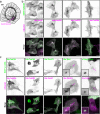Phylogenetic and functional characterization of water bears (Tardigrada) tubulins
- PMID: 36997657
- PMCID: PMC10063605
- DOI: 10.1038/s41598-023-31992-z
Phylogenetic and functional characterization of water bears (Tardigrada) tubulins
Abstract
Tardigrades are microscopic ecdysozoans that can withstand extreme environmental conditions. Several tardigrade species undergo reversible morphological transformations and enter into cryptobiosis, which helps them to survive periods of unfavorable environmental conditions. However, the underlying molecular mechanisms of cryptobiosis are mostly unknown. Tubulins are evolutionarily conserved components of the microtubule cytoskeleton that are crucial in many cellular processes. We hypothesize that microtubules are necessary for the morphological changes associated with successful cryptobiosis. The molecular composition of the microtubule cytoskeleton in tardigrades is unknown. Therefore, we analyzed and characterized tardigrade tubulins and identified 79 tardigrade tubulin sequences in eight taxa. We found three α-, seven β-, one γ-, and one ε-tubulin isoform. To verify in silico identified tardigrade tubulins, we also isolated and sequenced nine out of ten predicted Hypsibius exemplaris tubulins. All tardigrade tubulins were localized as expected when overexpressed in mammalian cultured cells: to the microtubules or to the centrosomes. The presence of a functional ε-tubulin, clearly localized to centrioles, is attractive from a phylogenetic point of view. Although the phylogenetically close Nematoda lost their δ- and ε-tubulins, some groups of Arthropoda still possess them. Thus, our data support the current placement of tardigrades into the Panarthropoda clade.
© 2023. The Author(s).
Conflict of interest statement
The authors declare no competing interests.
Figures





Similar articles
-
Miniaturization of tardigrades (water bears): Morphological and genomic perspectives.Arthropod Struct Dev. 2019 Jan;48:12-19. doi: 10.1016/j.asd.2018.11.006. Epub 2018 Dec 3. Arthropod Struct Dev. 2019. PMID: 30447338 Review.
-
Extensive loss of Wnt genes in Tardigrada.BMC Ecol Evol. 2021 Dec 27;21(1):223. doi: 10.1186/s12862-021-01954-y. BMC Ecol Evol. 2021. PMID: 34961481 Free PMC article.
-
The Unique Antimicrobial Recognition and Signaling Pathways in Tardigrades with a Comparison Across Ecdysozoa.G3 (Bethesda). 2020 Mar 5;10(3):1137-1148. doi: 10.1534/g3.119.400734. G3 (Bethesda). 2020. PMID: 31969428 Free PMC article.
-
A Hypothesis for the Composition of the Tardigrade Brain and its Implications for Panarthropod Brain Evolution.Integr Comp Biol. 2017 Sep 1;57(3):546-559. doi: 10.1093/icb/icx081. Integr Comp Biol. 2017. PMID: 28957526
-
Developmental and genomic insight into the origin of the tardigrade body plan.Evol Dev. 2024 Jul;26(4):e12457. doi: 10.1111/ede.12457. Epub 2023 Sep 18. Evol Dev. 2024. PMID: 37721221 Review.
Cited by
-
Complex evolutionary patterns within the tubulin gene family of ciliates, unicellular eukaryotes with diverse microtubular structures.BMC Biol. 2024 Aug 13;22(1):170. doi: 10.1186/s12915-024-01969-z. BMC Biol. 2024. PMID: 39135200 Free PMC article.
References
-
- Fleming JF, Arakawa K. Systematics of tardigrada: A reanalysis of tardigrade taxonomy with specific reference to Guil et al. (2019) Zool. Scr. 2021;50:376–382. doi: 10.1111/zsc.12476. - DOI
-
- Møbjerg N, Jørgensen A, Kristensen RM, Neves RC. Morphology and functional anatomy. In: Schill RO, editor. Water Bears: The Biology of Tardigrades. Springer International Publishing; 2018. pp. 57–94.
-
- Czerneková M, Vinopal S. The tardigrade cuticle. Limnol. Rev. 2021;21:127–146. doi: 10.2478/limre-2021-0012. - DOI
Publication types
MeSH terms
Substances
LinkOut - more resources
Full Text Sources
Research Materials

